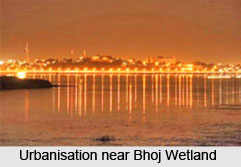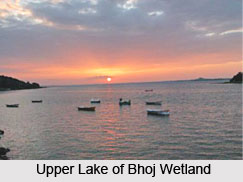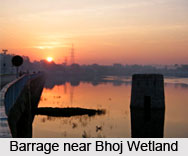 Bhoj Wetland situated in the city of Bhopal, the capital of Madhya Pradesh consists of two lakes.
Bhoj Wetland situated in the city of Bhopal, the capital of Madhya Pradesh consists of two lakes.
Bhoj Wetland consists of two lakes like: Upper Lake and Lower Lake, which lie to the west of the city of Bhopal.
The Upper Lake of Bhoj Wetland was created by the ruler of Malwa, King Bhoj. After the construction of an earthen dam across the Kolan river the lake was created. The Upper Lake is spread over an area of thirty-one square kilometres and has a catchment area of 361 square kilometres.
History of Bhoj Wetland
The Lower Lake was created by Nawab Chotte Khan, Minister of Nawab Hayath Mohammad in 1794. Bhoj Wetland was built to beautify the city. The Lower Lake of Bhoj Wetland is spread over an area of 1.29 square kilometres with a catchments area of 9.6 square kilometres. Bhoj Wetland provides shelter to a diverse range of flora and fauna. The lake has been notified as a wetland of international importance under the international Ramsar Convention. Bhoj Wetland is consisting of two important medieval artificial lakes, which are manmade reservoirs.
Upper Lakes of Bhoj Wetland
Upper Lake or Badee talab was created in 11th century and has a partial urban component in its catchment (361 sq km in area) on the eastern end while the remainder is rural. The Upper Lake has reduced from initial 30 sq. kilometres to 8 sq. kilometres as of now. The Lower Lake also got reduced from 8 sq km in the beginning to 2 sq. kilometres in 2009.
 Lower Lake of Bhoj Wetland
Lower Lake of Bhoj Wetland
The Lower lake of Bhoj Wetland, locally known as Chhota Talab, was created in 18th century and is situated towards the east end of Upper lake and is fully surrounded by built-up areas. Compared to the Upper Lake it has a small catchment area of 9.60 sq km. The wetland supports a wide variety of flora and fauna and is rich in bio-diversity. A total of more than 20,000 birds have been observed annually. Bhoj Wetland was recognized as a wetland of international importance under the Ramsar Convention of 1971 in 2002. The Upper Lake acts as the lifeline of the city supplying 40 % of the total potable water.
Geography of Bhoj Wetlands
The total length of Bhoj Wetland was 38 kilometres, but it reduced to 5 kilometres in 2009.Various threats on lakes include, siltation due to soil erosion of the catchment area and inflow of untreated sewage and wastewater from the surrounding human settlements.
Utility of Bhoj Wetlands
The lakes of Bhoj Wetland are also used daily by more than 2,000 people daily to bathe, wash clothes and clean their vehicles; the immersion of idols and tazias are common in these water bodies. There is encroachment in catchment areas of these two wetlands for slum development, agricultural activities and tourism. The use of motorboats by the tourism department has also increased the pollution level of the lake water. Since the Lower Lake of Bhoj Wetlands is located within an urban area hence it is subjected to many negative anthropogenic stresses, its water quality degradation has been much more than the upper lake.
 Developments to Bhoj Wetland
Developments to Bhoj Wetland
In 1995, the Government of Madhya Pradesh initiated Rs.2.5 billion project for conservation of Bhoj wetland, with money borrowed from the Japanese Bank of International Cooperation (JBIC). Under this Bhopal Lake Conservation and Management Project, the regular water quality monitoring of both the lakes were done. For this purpose 18 stations in Upper Lake and 14 stations in Lower Lake have been fixed. Physico - chemical and biological parameters were regularly analyzed. Instead of its pre-determined tenure of 5 years, the project went for 9 years.



















